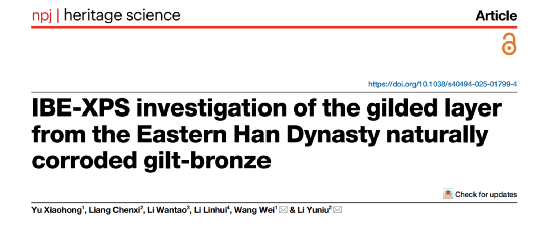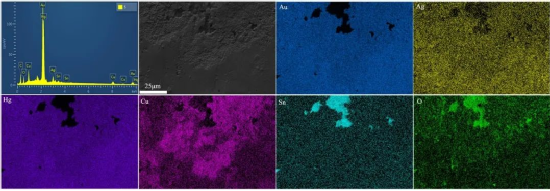npj Herit. Sci. | IBE-XPS investigation of the gilded layer from the Eastern Han Dynasty naturally corroded gilt-bronze

Recently, Xizang Minzu University, the Center for Archaeological Sciences, Sichuan University, the Sichuan Provincial Institute of Cultural Relics and Archaeology, and the Tibet Autonomous Region Institute of Cultural Relics Protection jointly published a research paper titled “IBE-XPS investigation of the gilded layer from the Eastern Han Dynasty naturally corroded gilt-bronze” in the international academic journal npj Heritage Science.
The study analyzed the gilded layers on the surface of three naturally corroded gilt-bronze artifacts from the Eastern Han Dynasty using ion beam etching X-ray photoelectron spectroscopy (IBE-XPS) and scanning electron microscopy (SEM).

Figure 1 Three naturally corroded gilt-bronze artifacts from the Eastern Han Dynasty.
The three gilt-bronze artifacts originated from the Dafenbāo Cemetery in Pengshan District, Meishan City, Sichuan Province. They were severely corroded, with no remaining bronze substrate in the artifacts. The three samples analyzed in this study were taken from the tail sections of the gilt-bronze artifacts, where the gilded layer could be clearly observed.

Figure 2 SEM, EDS, and elemental mapping spectra of Sample 2.
The results indicate that these artifacts were produced using the fire-gilding technique. The main elements in the gilded layer include gold, silver, copper, and tin, and it is severely oxidized.

Figure 3 XPS spectra of the sample and a bar chart showing the percentage content of copper, tin, silver, gold, and oxygen in the gilded layer at different etching times.
A high oxygen content (O1s) was observed on the surface of the gilded layer in the full XPS spectra. Combining the XPS and EDS results, high-resolution X-ray photoelectron spectroscopy (HR-XPS) was performed for Au4f, Ag3d, Cu2p, and Sn3d.
The HR-XPS results indicate that gold mainly exists in its zero-valent state within the gilded layer and is relatively stable. The Au4f spectrum of Sample 2 shows that after 30 minutes of etching, the analysis was approaching the interface between the gilded layer and the bronze substrate. Considering the galvanic coupling reaction, the migration mechanism of silver is inferred as follows: silver migrated uniformly from the interface to the surface of the gilded layer in its monovalent state, where it accumulated and oxidized, leading to a slight increase in its binding energy. The detected copper and tin elements are presumed to originate from the underlying bronze substrate. Among them, copper exists in both divalent and monovalent forms within the gilded layer, distributed on the surface and in the interior of the gilded layer, respectively; while the tin content shows an increasing trend from the surface to the interior, indicating its origin from the underlying bronze substrate, existing mainly in its tetravalent state, with some divalent tin also detected within the gilded layer. Furthermore, because divalent copper and tetravalent tin are relatively prone to leaching into the soil, the lower content of copper and tin on the surface of the gilded layer may also be related to long-term burial.
This study, for the first time, applied IBE-XPS to analyze the surface and interior of the gilded layer of ancient Chinese gilt-bronze artifacts, and inferred the migration process of major ions within the gilded layer based on these findings. It is also the first application of this method to the surface study of gilt-bronze artifacts excavated from the Han Dynasty, providing new data and information for studying the surface and internal changes of ancient gilt-bronze gilded layers.
Associate Professor Yu Xiaohong from Xizang Minzu University and PhD candidate Liang Chenxi from the School of Archaeology and Museology, Sichuan University, are co-first authors of this paper. Wang Wei from Xizang Minzu University and Associate Professor Li Yuniu from the Center for Archaeological Sciences and the School of Archaeology and Museology, Sichuan University, are co-corresponding authors. Associate Researcher Li Wantao from the Sichuan Provincial Institute of Cultural Relics and Archaeology and Researcher Li Linhui from the Tibet Autonomous Region Institute of Cultural Relics Protection are co-authors. Senior Experimentalist Yan Shuguang from the Analytical and Testing Center, Sichuan University, and Experimentalist Zhang Guiying from the Center for Archaeological Sciences, Sichuan University, provided significant assistance with the analysis results for this study.
This research was supported by the Tibet Autonomous Region Major Science and Technology Project for Tibetan Cultural Heritage Preservation and Restoration (Grant No. XZ202201ZD0002G), the National Natural Science Foundation of China (Grant No. T2350410495), Sichuan University (Grants No. SKSYL2023-05, 2035xd-02), among others.
Author: Liang Chenxi
Reviewed by: Li Yuniu
